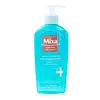What's inside
What's inside
 Key Ingredients
Key Ingredients

 Benefits
Benefits

 Concerns
Concerns

 Ingredients Side-by-side
Ingredients Side-by-side

Water
Skin ConditioningDimethicone
EmollientGlycerin
HumectantHydrogenated Polyisobutene
EmollientAlcohol Denat.
AntimicrobialButylene Glycol
HumectantGlyceryl Stearate
EmollientSalicylic Acid
MaskingAmmonium Polyacryloyldimethyl Taurate
Emulsion StabilisingIsopropyl Lauroyl Sarcosinate
Skin ConditioningOctyldodecanol
EmollientAcrylonitrile/Methyl Methacrylate/Vinylidene Chloride Copolymer
Capryloyl Glycine
CleansingCapryloyl Salicylic Acid
ExfoliatingDimethicone/Vinyl Dimethicone Crosspolymer
Skin ConditioningDisodium EDTA
PEG-100 Stearate
Perlite
AbsorbentPhenylethyl Resorcinol
AntioxidantPoloxamer 338
EmulsifyingSilica
AbrasiveSilica Silylate
EmollientSodium Hydroxide
BufferingSodium Polyacrylate
AbsorbentStearyl Alcohol
EmollientXanthan Gum
EmulsifyingZinc PCA
HumectantParfum
MaskingWater, Dimethicone, Glycerin, Hydrogenated Polyisobutene, Alcohol Denat., Butylene Glycol, Glyceryl Stearate, Salicylic Acid, Ammonium Polyacryloyldimethyl Taurate, Isopropyl Lauroyl Sarcosinate, Octyldodecanol, Acrylonitrile/Methyl Methacrylate/Vinylidene Chloride Copolymer, Capryloyl Glycine, Capryloyl Salicylic Acid, Dimethicone/Vinyl Dimethicone Crosspolymer, Disodium EDTA, PEG-100 Stearate, Perlite, Phenylethyl Resorcinol, Poloxamer 338, Silica, Silica Silylate, Sodium Hydroxide, Sodium Polyacrylate, Stearyl Alcohol, Xanthan Gum, Zinc PCA, Parfum
Water
Skin ConditioningSodium Laureth Sulfate
CleansingPEG-8
HumectantCoco-Betaine
CleansingHexylene Glycol
EmulsifyingSodium Chloride
MaskingCaprylyl Glycol
EmollientCitric Acid
BufferingGlycerin
HumectantMoringa Oleifera Seed Extract
Skin ConditioningPEG-120 Methyl Glucose Dioleate
EmulsifyingPhenoxyethanol
PreservativeSodium Benzoate
MaskingSodium Hydroxide
BufferingZinc PCA
HumectantParfum
Masking
 Reviews
Reviews

Ingredients Explained
These ingredients are found in both products.
Ingredients higher up in an ingredient list are typically present in a larger amount.
Glycerin is already naturally found in your skin. It helps moisturize and protect your skin.
A study from 2016 found glycerin to be more effective as a humectant than AHAs and hyaluronic acid.
As a humectant, it helps the skin stay hydrated by pulling moisture to your skin. The low molecular weight of glycerin allows it to pull moisture into the deeper layers of your skin.
Hydrated skin improves your skin barrier; Your skin barrier helps protect against irritants and bacteria.
Glycerin has also been found to have antimicrobial and antiviral properties. Due to these properties, glycerin is often used in wound and burn treatments.
In cosmetics, glycerin is usually derived from plants such as soybean or palm. However, it can also be sourced from animals, such as tallow or animal fat.
This ingredient is organic, colorless, odorless, and non-toxic.
Glycerin is the name for this ingredient in American English. British English uses Glycerol/Glycerine.
Learn more about GlycerinParfum is a catch-all term for an ingredient or more that is used to give a scent to products.
Also called "fragrance", this ingredient can be a blend of hundreds of chemicals or plant oils. This means every product with "fragrance" or "parfum" in the ingredients list is a different mixture.
For instance, Habanolide is a proprietary trade name for a specific aroma chemical. When used as a fragrance ingredient in cosmetics, most aroma chemicals fall under the broad labeling category of “FRAGRANCE” or “PARFUM” according to EU and US regulations.
The term 'parfum' or 'fragrance' is not regulated in many countries. In many cases, it is up to the brand to define this term.
For instance, many brands choose to label themselves as "fragrance-free" because they are not using synthetic fragrances. However, their products may still contain ingredients such as essential oils that are considered a fragrance by INCI standards.
One example is Calendula flower extract. Calendula is an essential oil that still imparts a scent or 'fragrance'.
Depending on the blend, the ingredients in the mixture can cause allergies and sensitivities on the skin. Some ingredients that are known EU allergens include linalool and citronellol.
Parfum can also be used to mask or cover an unpleasant scent.
The bottom line is: not all fragrances/parfum/ingredients are created equally. If you are worried about fragrances, we recommend taking a closer look at an ingredient. And of course, we always recommend speaking with a professional.
Learn more about ParfumSodium Hydroxide is also known as lye or caustic soda. It is used to adjust the pH of products; many ingredients require a specific pH to be effective.
In small amounts, sodium hydroxide is considered safe to use. However, large amounts may cause chemical burns due to its high alkaline.
Your skin has a natural pH and acid mantle. This acid mantle helps prevent harmful bacteria from breaking through. The acid mantle also helps keep your skin hydrated.
"Alkaline" refers to a high pH level. A low pH level would be considered acidic.
Learn more about Sodium HydroxideWater. It's the most common cosmetic ingredient of all. You'll usually see it at the top of ingredient lists, meaning that it makes up the largest part of the product.
So why is it so popular? Water most often acts as a solvent - this means that it helps dissolve other ingredients into the formulation.
You'll also recognize water as that liquid we all need to stay alive. If you see this, drink a glass of water. Stay hydrated!
Learn more about WaterZinc PCA (or "zinc salt") differs slightly from zinc itself. PCA stands for pyrrolidone carboxylic acid. However, Zinc PCA comes from zinc.
It can help reduce redness, regulate sebum, and promote the general healing process of the skin.
Zinc PCA tends to be especially useful for those with oily, acne-prone skin. It's certainly an ingredient worth trying out!
Learn more about Zinc PCA